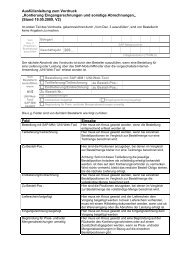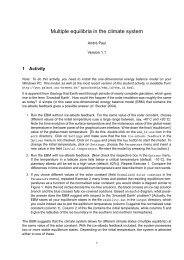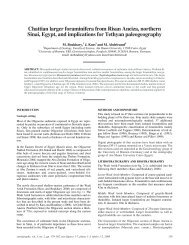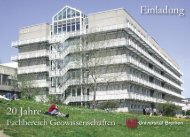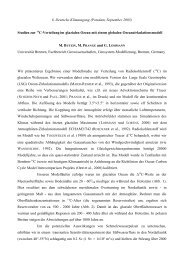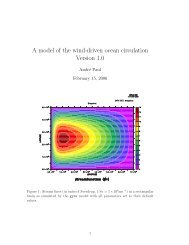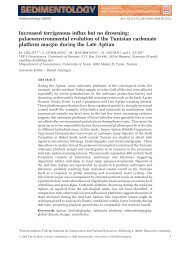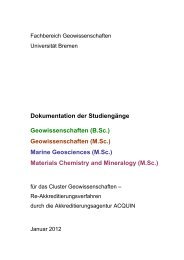Forschung im HLRN-Verbund 2011
Forschung im HLRN-Verbund 2011
Forschung im HLRN-Verbund 2011
- Keine Tags gefunden...
Sie wollen auch ein ePaper? Erhöhen Sie die Reichweite Ihrer Titel.
YUMPU macht aus Druck-PDFs automatisch weboptimierte ePaper, die Google liebt.
106Turbulence s<strong>im</strong>ulations for greener and quieter air transportFurther development of DES for the s<strong>im</strong>ulation of complex turbulent flowsC. Mockett, B. Greschner, L. Wang, F. Thiele,Institut für Strömungsmechanik und TechnischeAkustik, Technische Universität BerlinAbstract• Turbulent flow increases fuel consumption andnoise in air transport.• Precise computational fluid dynamics (CFD) forturbulent flow requires next-century computingpower; affordable turbulence models are unreliable.• Hybrid approach “detached-eddy s<strong>im</strong>ulation”(DES) a<strong>im</strong>s at reliable turbulence prediction withnear-future computational resources.• Method development for s<strong>im</strong>ple flows; technologydemonstration on complex application challenges.The flow of gases or liquids can be laminar (smoothand unchanging in t<strong>im</strong>e) or turbulent (characterisedby a chaotic and unsteady mixture of eddies with awide range of different sizes). Turbulence is therule rather than the exception in practical flows,and is a very <strong>im</strong>portant phenomenon related tomixing, heat transfer, energy dissipation and soundgeneration. The last two are particularly relevantto aerospace applications, since turbulence is responsiblefor much of the aerodynamic resistanceand noise that defines the environmental <strong>im</strong>pactof air transport: fuel consumption, emissions andnoise pollution.Although computer-aided engineering is increasinglyemployed by industry in efficient product design,computational fluid dynamics (CFD) lacksmaturity in comparison with other disciplines. A keyreason for this is turbulence: Although it is possibleto s<strong>im</strong>ulate turbulent flow accurately by resolvingthe motion of every eddy in t<strong>im</strong>e and threed<strong>im</strong>ensionalspace, for practical applications thisrequires computing power not expected until thenext century [2]. Alternatively, the effect of the turbulenceon the flow can be modelled, making CFDfor turbulent flow affordable today. However, suchmodels are calibrated for specific types of flow andtypically give very unreliable results in different applications.The EU-funded ATAAC project [1] is tasked withdeveloping and <strong>im</strong>proving turbulence methods forCFD, with a particular emphasis on air transportapplications. The TU Berlin is one of 22 projectpartners, with its focus on a methodology knownas detached-eddy s<strong>im</strong>ulation (DES). Since its introductionin 1997 [2], DES has become one ofthe most promising methods of its kind [3][4]. DESa<strong>im</strong>s to provide reliable, t<strong>im</strong>e-resolved turbulences<strong>im</strong>ulation with the computing capacity expectedto become routine in the near future. The development,testing and demonstration of the methodtherefore requires large computing resources bytoday’s standards and the contingent provided bythe <strong>HLRN</strong> is essential to the success of the project.DES can be described as a hybrid approach,whereby accurate resolution of the turbulent eddiesis combined with efficient modelling in different regionsof the flow.In order to thoroughly test the DES methodand to assess any <strong>im</strong>provements as well as the<strong>im</strong>portance of various s<strong>im</strong>ulation setup issues, awide range of different configurations are beings<strong>im</strong>ulated. S<strong>im</strong>plified geometries and canonicalflows are employed for parameter studies, validationand method development due to their lowcomputational expense and high-quality benchmarkdata. These include test cases such asfully-developed planar channel flow, a channel witha two-d<strong>im</strong>ensional “hill” causing flow recirculation,the flow around tandem cylinders and a s<strong>im</strong>plifiedaircraft landing gear. Complex “application challenge”test cases are s<strong>im</strong>ulated in order to demonstratethe robustness and quality of the <strong>im</strong>provedturbulence modelling techniques for industrial configurations.Examples include a the flow around ahelicopter fuselage and the flow inside an aircraftengine air intake exerted to a crosswind.Depending on the size of the problem, between16 and 256 CPUs are employed in parallel for eachs<strong>im</strong>ulation. Although these numbers are relativelymodest, the high computational expense arisesdue to the very long s<strong>im</strong>ulation run t<strong>im</strong>es (oftenup to several weeks). This is necessary to obtainlong t<strong>im</strong>e samples for accurate statistical quantities(e.g. the t<strong>im</strong>e-averaged flow speed and directionthroughout the configuration).Turbulent eddies also generate pressure fluctuations,which can give rise to strong sound sourcesin the flow. A practical example of such aeroacousticsound generation, which leads to considerableenvironmental disturbance, is airframe noise: Protrudingcomponents on landing aircraft, such aslanding gear and flaps, generate strong turbulentfluctuations and high levels of noise, particularlywhen the eddies interact with other parts of the aircraft.By avoiding the resolution of the turbulentfluctuations in the s<strong>im</strong>ulation, turbulent sound gen-Ingenieurwissenschaften



